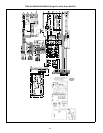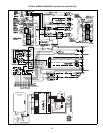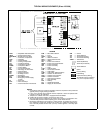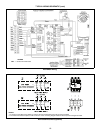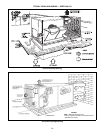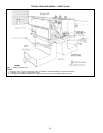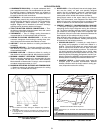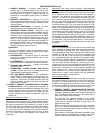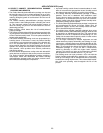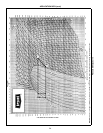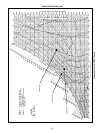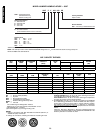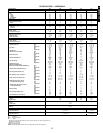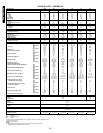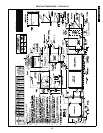
22
APPLICATION DATA (cont)
c.
HUMIDITY DAMAGE —
Humidity causes property
damage, such as stained wallpaper and ceiling tiles.
Humidity can also damage books and artwork, and cre-
ate strong odors in carpets. In addition, humidity can
contribute to unacceptable product quality in industrial
processes.
d.
IMPROPER VENTILATION —
Buildings in hot and
humid geographical areas cannot be properly ventilated
due to high humidity levels outdoors, resulting in poor
indoor-air quality.
e.
EQUIPMENT INEFFICIENCY —
Humidity can cause
inefficient operation of refrigerators and freezers.
f.
INCREASED ENERGY COSTS —
Because of high
humidity levels and less comfortable conditions, thermo-
stat set points are lowered to force the HVAC (heating,
ventilation, and air conditioning) equipment to run longer
and work harder to lower the humidity levels. Also, in an
attempt to control humidity, system designers typically
oversize HVAC equipment and add reheat capability to
get the desired latent capacity. This results in higher ini-
tial equipment costs, as well as increased energy
expenses throughout the life of the unit.
Applications
There are many different rooftop unit applications that are
susceptible to problems caused by high humidity levels.
Some common applications include:
a.
RESTAURANTS —
The kitchen areas of restaurants
have many humidity-producing activities, such as dish
washing and cooking.
b.
SUPERMARKETS —
High humidity levels cause ineffi-
ciency in operation of refrigeration and freezer systems.
c.
MUSEUMS AND LIBRARIES —
Humidity can damage
books and artwork.
d.
GYMNASIUMS, LOCKER ROOMS, AND HEALTH
CLUBS —
Shower areas and human perspiration cause
uncomfortable occupied space conditions.
e.
HOT AND HUMID CLIMATES —
The southeastern
United States is a good example of this application. The
Perfect Humidity dehumidification package becomes
particularly useful when increased amounts of the hot
and humid outdoor air need to be brought into the build-
ing for proper ventilation.
13.
PERFECT HUMIDITY DEHUMIDIFICATION PACKAGE
DESIGN EFFECTS —
To fully understand the operation of
the Perfect Humidity dehumidification package, refer to the
pressure enthalpy curve, and analyze the Perfect Humidity
package effects on the refrigerant in the rooftop unit. The
pressure enthalpy curve shows the refrigerant cycle for a
rooftop unit.
Standard Unit Refrigerant Cycle
At point no. 1 in the pressure enthalpy curve, vapor leaving the
compressor at a high pressure and a high temperature enters
the condenser. The condenser removes heat from the refriger-
ant, lowers its temperature, and changes it to a liquid. At point
no. 2, the liquid leaves the condenser and enters a fixed expan-
sion device that lowers the pressure of the refrigerant. At point
no. 3, the liquid enters the evaporator coil, where the refrigerant
increases in temperature and changes back to a vapor. At point
no. 4, the vapor leaves the evaporator and reenters the
compressor.
Refrigerant Cycle Using Perfect Humidity™ Dehumidification
Package
When a subcooler coil is added to the rooftop unit, the refriger-
ant is affected in such a way that the unit latent capacity is
increased. The refrigerant cycle follows the same path from
point no. 1 to point no. 2 as the standard refrigerant cycle with-
out a subcooler (see the pressure enthalpy curve). However, at
point no. 2, the liquid refrigerant enters the subcooler coil where
the temperature is lowered further. At point no. 2A, this sub-
cooled liquid enters the TXV, which drops the pressure of the
liquid. At point no. 2B, the liquid enters the fixed orifice metering
device. The refrigerant leaves this device as a saturated vapor
and enters the evaporator at point no. 2C. The improved refrig-
eration effect can now be seen between point no. 2C and point
no. 3. The increase in the total refrigeration effect is the addi-
tional enthalpy gained from point no. 2C to point no. 3. However,
the subcooler coil rejects this added refrigeration effect to the
air downstream of the evaporator coil, thus maximizing the over-
all latent effect. This improved latent effect is a direct result of
the addition of the Perfect Humidity subcooler coil to the refrig-
erant cycle.
Latent Capacity Effects
Refer to the psychrometric chart to see how the sensible heat
factor decreases when the optional Perfect Humidity dehumidifi-
cation package is installed. This chart contains data for the
5-ton unit operation, both with and without the Perfect Humidity
package, at 1750 cfm. Point no. 1 on the chart represents the
return-air dry bulb (80 F) and wet bulb (67 F) conditions. Point
no. 2 represents the supply-air conditions for a standard rooftop
unit without the Perfect Humidity dehumidification package.
Point no. 3 represents the supply-air conditions for a rooftop unit
with the Perfect Humidity package. By connecting point no. 1
and point no. 2 on the chart and finding the intersection on the
sensible heat factor scale, the sensible heat factor is 0.73. Con-
nect point no. 1 and point no. 3, and see that the sensible heat
factor is 0.58. This is a 17.5% increase in latent capacity for the
given conditions. This increase in latent capacity allows the
rooftop units to remove more moisture from the conditioned
space; thus lowering the humidity levels.
Dehumidification Effects
Further evidence of dehumidification can be seen by analyzing
the pounds of water per pound of dry air found in the supply air.
At point no. 2 in the psychrometric chart, there are 65 grains
(0.0092 lb) of moisture per pound of dry air. At point no. 3, there
are 58 grains (0.0083 lb) of moisture per pound of dry air. This
is a 12.1% decrease in the amount of water in the supply air.
14.
PERFECT HUMIDITY DEHUMIDIFICATION PACKAGE
OPERATING PERFORMANCE —
Perfect Humidity dehu-
midification package operation does not affect the electrical
data. The electrical data remains the same either with or
without the Perfect Humidity package.
The operating and shipping weights will be slightly
increased with the addition of the Perfect Humidity sub-
cooler. See the Physical Data table for added base unit
weight with this option.
Refer to cooling performance data, both with and without
the Perfect Humidity dehumidification package. Note the
greatly improved latent capacity with the Perfect Humidity
dehumidification package.
Static pressure is also slightly affected by the addition of the
Perfect Humidity dehumidification package. See Static
Pressure Drop table on page 94 when using this option.



